THE MECHANICS OF CONTINUATION
By the courtesy of Ogingo Videography, Sabah, Malaysia.
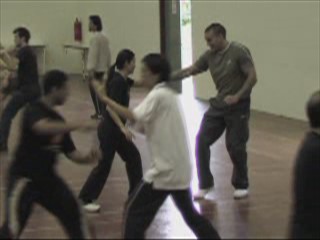
Participants of varying levels of attainment practicing together and enjoying themselves
Combat sequences are our forte in our sparring methodology. Amongst many benefits, they help you to overcome two major problems many martial artists face when sparring, one faced by an initiator, or attacker, and the other faced by a responder, or defender.
A major problem many initiators face is wondering what pattern to use next. When you use a combat sequence, you don't have this problem, you merely execute the sequence.
A major problem many responders face is how to use proper kungfu patterns to respond correctly and spontaneously to random attacks. This is indeed a big problem for many martial artists. When they start thinking of what patterns to use, they become hesitant, and soon discover that punches and kicks rain on them.
The secret is that in combat you do not think. Whatever thinking there may be, has been done in pre-combat training. In combat you just respond spontaneously and correctly. Combat sequences provide you a systematic way to do so.
Of course, you would not be able to do this if you have not been systematically trained. This is the situation most other kungfu practitioners all over the world are facing now. This explains why they are unable to use kungfu for combat.
Some non-Shaolin Wahnam members reading this may again accuse us of being boastful or conceited. That is their opinion and their business, and we are not going to waist our time on their opinion. We state a truth courageously, and are generous enough to share relevant secrets with those who may want to benefit from reading our webpages.
A defender may successfully use kungfu patterns to defend against attacks coming in a pre-arranged order, but how can he defend against attacks coming at random? Such skills will be trained in later stages of our sparring methodology.
At the earlier stages, you condition yourself to respond spontaneously and correctly to certain attacks. If an opponent throws you a middle-level punch, for example, you spontaneously respond with “Single Tiger”. If he throws you a low-level punch, your spontaneously respond with “Hand Sweep”. It is like using language. When you have to say something in a given situation, you just say it spontaneously. You don't have to think of what words and what grammar to use.
These early stages are mainly covered in Sequences 1 to 4, which also develop some fundamental combat skills. Sequences 5 to 8 expand your repertoire of hand attacks and defences.
When you have completed one sequence, logically you can continue with another sequence. The video clips below show the mechanics involved in the continuation from one sequence to another.
Continuation by Gliding Forward
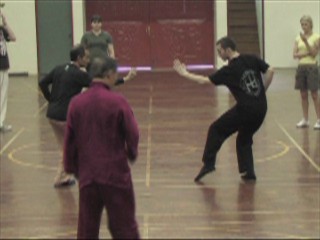
Alejandro of Spain, who is a beginner, and Sifu Jamie of England, who is a master, perform Sequence 5. A special feature in Shaolin Wahnam is that practitioners of vastly different levels can practice and benefit together. As both the completing and the continuing sequences use the left-leg mode, Alejandro needs only to glide his left leg forward. But he must ask the way, which he can accomplish by opening or closing the opponent's leading hand.
Continuation by Stepping Forward
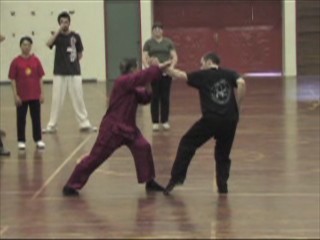
If you continue from Sequence 5 to Sequence 4, for example, where the leg mode is from left to left, you merely glide forward. But if you continue from Sequence 5 to another Sequence 5, where the leg mode changes from left to right, you step forward. You may need to make some spacing adjustment.
Sparring Partners of Varying Attainment Levels

Participants of varying attainment levels enjoy their practice and derive benefits according to their levels. Mohamed, a national Taekwondo champion, is practicing with Wei Joo, an intermediate student. Bernadette, a beginner, is practicing with Mark, a security chief whose expertise is combat and who is heavier and a head higher than his demure sparring partner. In genuine kungfu, size and muscular superiority do not matter.
Continuation with Drag Step
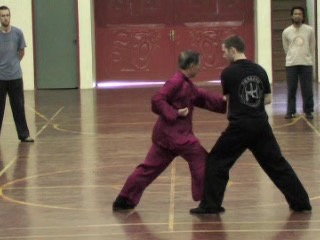
Now it is the initiator, not the responder, who makes the continuation. Grandmaster Wong shows how you can continue from Sequences 5 to Sequence 5, or to any one of the Sequences 5 to 8 which start with the right leg mode. As the opponent is some distance away, it is necessary to close the gap for correct spacing.
Adjusting Leg Modes in Continuation
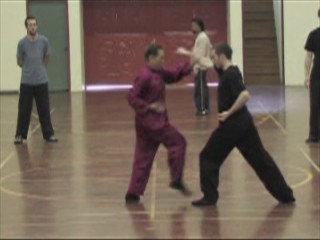
Grandmaster Wong demonstrates how the initiator can continue from Sequence 5 to any one of Sequences 1 to 4. Here the leg mode is from right to left. He also reviews how you can continue from Sequence 5 to any one of Sequences 5 to 8, where the leg mode is from right to right.
LINKS
Review of the Intensive Shaolin Kungfu Course in Sabah in March 2007
- Overview 1 : The Fundamentals
- Overview 2 : The 16 Combat Sequences
- Overview 3 : Are They Performing Kungfu Dance?
- The Basics of Shaolin Kungfu Training
- Fundamental Combat Skills
- Defeat you Hand to your Opponent, Victory you Create Yourself
- Avoiding Disadvantages and Seeking Advantages
- Basic Principles and Tactics of Combat
- Skills derived from Sparring can be Rewardingly used in Daily Life
- Some Secrets in Practicing Genuine Kungfu
-
Various Ways to Move into an Opponent
- Applying Combat Sequences in Sparring
- Linking Sequences to be More Combat Efficient
- The Secrets of Continuous Cannons
- The Mechanics of Continuation
- Marvelous Techniques Beget Marvelous Techniques
- Perfecting Forms and Developing Force
- Applying Tactics in Combat
-
Objectives of Form Training in Solo
- Being Fluent in Kicking Techniques before Applying them in Combat
- Using Tactics in Kicking Attacks and Defences
- Different Levels of Sophistication in Sparring and Fighting
- The Legacy of Uncle Righteousness: Secret of Continuous Cannons and their Counters
-
Benefiting from the Experiences and Teachings of Past Masters
- Poetic Patterns Can be Very Deadly
- Moving Back One Step when in Diffiuclt Situations
- Linking Sequences to Form a Kungfu Set
- Felling Techniques in Kungfu are Different from Judo and Wrestling
- Butterfly Palms and Hiding Flowers are Excellent in Countering Felling and Gripping Attacks
-
Let Mercy Flow from the Hands
- Benefits of Solo Set Practice — Combat Sequences 13 to 16
- From Pre-Choice Sequences to Free Sparring
- Applying Shaolin Patterns Correctly and Spontaneously in Free Sparring
- Shaolin Kungfu against Boxing and Kick-Boxing
- Shaolin Counters against Wrestling Shoots
- The Secret of Grandmaster Ho Fatt Nam
- Why Shaolin Kungfu is Technically Faster than Boxing
- Shaolin Techniques, Tactics and Strategies against Boxing
- Revealing Secrets of Past Taijiquan Masters
- Overwhelming Opponents with Just One Pattern
- Poetry and Elegance in Effective Combat
